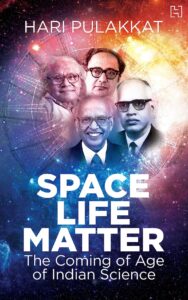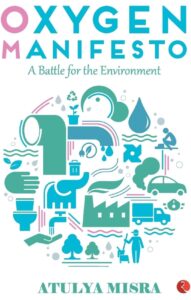

Truth Trumpet has a collection of science book suggestions and reviews to help you decide which books to go through and to add to your library! Its goal is to put together a repository of popular science books that might interest you.






As the COVID-19 pandemic was creating havoc around the planet, Archana Sharma and Spoorthy Raman were working at ungodly hours. Sharma, a senior physicist at CERN, in Europe, and Raman, a Canada-based science journalist, were working towards their new book, India’s Science Geniuses (and the Problems They are Solving).
For Sharma, it was very early in the morning. For Raman, it was very late at night. They worked through these hours, talking to 30 scientists whose work would later make it into the book.
Released to the public in late June this year, the book has drawn the attention of several people in the Indian science ecosystem. The cover quotes former secretary of the Department of Science and Technology, Ashutosh Sharma, calling the book “eye-opening”.
The book is a compelling, fast-paced read and fills the vacuum of accessible and affordable literature about contemporary Indian scientists. It locates the work of the featured scientists in the context of Nobel Prize-winning discoveries that have happened worldwide. In doing so, it paints a glorious picture of the Indian science ecosystem.
And that’s where the book launches itself into dangerous territories.
Reviewed by: Sayantan Datta on Science The Wire
From enhanced nuclear capability to an unmanned Moon mission, India s scientific achievements in recent years have been spectacular. But, according to the country s best-known scientist A.P.J. Abdul Kalam and his close associate Y.S. Rajan, we ve only just begun. In a century that many experts predict may belong to India, the realization of the vision of a better future for everyone will require a keen understanding of our needs and this can only be achieved by tailoring our research and innovations to the goal of national development.
In The Scientific Indian, the authors of the path-breaking India 2020: A Vision for the New Millennium return after ten years to the core areas of scientific advancement that are crucial space exploration, satellite technology, missile development, earth and ocean resources, the biosphere, food production, energy and water harvesting, health care and communications, to name a few. For each aspect, the authors discuss Indian breakthroughs within the context of recent progress on the global platform, before outlining a pragmatic vision of technological development that will propel India to the forefront of the world in the decades to come.
The Scientific Indian will speak to every curious and adventurous mind, and especially to tomorrow s scientists and technologists, encouraging us to dream big, and urging us to work hard to make our dreams come true.
After a hiatus of ten years, the authors of path-breaking India 2020: A Vision for the New Millennium return with a book on some crucial core areas of scientific advancement. A scientific vision for the future from India s most respected scientist.
Reviewed on Goodreads
Link to Order: The Scientific Indian: A Twenty-First Century Guide To The World Around Us
The basis behind the book has been set forth right in the preface. “Education is not delivered; it is constructed or created by each child. Observation and curiosity to understand what is observed is an integral component of living and grown up” It is a collection of 274 questions posed to prof. Yash Pal by curious readers young and old, which he has answered in his inimitable style.
D. BALASUBRAMANIAN. The Hindu, June 16, 2011
Link to Order: Random Curiosity
Sobel masterly weaves in the complexity of the subject (astrophysics) with human interest stories about her characters. Though her brief explanations of scientific content are fairly lucid, the content itself is just about enough to follow the narrative.
SHOBHIT MAHAJAN. Outlook 18 December 2017
Link to Order: The Glass Universe: The Hidden History of the Women Who Took the Measure of the Stars
The book chronicles the epochal struggles of India to meet what Agarwal calls the “challenge of balance”, between growth equity and conservation. His obsessive campaign for a ministry for environment and forests and his citizen’s report on the environment raised environmental activism in the country to its present meaningful state during the last quarter century.
SACHIDANANDA MURTHY. The Week, June 3, 2007
Link to Order: Anil Agarwal Reader (Vol. 1, 2 and 3)
Squadron Leader K. K. Nair writes a pervasive treatise covering most areas of the use of space for national security. It provides a comparative overview of military space theories and doctrines, considers space law and its military applications, looks at the Great Asian Space Militarisation Race, and proposes space-based options for national power, for fulfilling defence requirements and for managing future space capabilities.
RAMINDER KAUR. The Week, June3, 2007
Link to Order: Space: The Frontiers of Modern Defence
Her well-written account tries to show up scientists as real people – “men (and some women) who needed to earn their living, who made mistakes, who tramples down their rivals, or even sometimes got bored and did something else.
ITHAL C NADKARNI. The Crest, December 5, 2009
Link to Order: Science: A Four Thousand Year History
Throughout his narrative, Mascarenhas maintains that Bangalore’s reputation of being a technopolis preceded the “IT outsourcing boom”, which, he says, rode on the back of a “scientific base” established by public sector research and educational institutes in the city.
DEEPA KURUP
Link to Order: India’s Silicon Plateau – Development of Information and Communication Technology in Bangalore
Not just scientific facts and concepts, Pulakkat weaves in anecdotal stories of the doyens of Indian science. Tales of struggles make this a valuable book.
PALLAVA BAGLA. Outlook. December 4, 2021
Link to Order: Space. Life. Matter: The Coming of Age of Indian Science
(The book) contends that the only practicable way of expanding human knowledge is by an unending feedback process of criticism.
CETAN PARIKH. Business World, 26 January 2004
Link to Order: Conjectures and Refutations
How can a single particle behave both like a particle and a wave? Does a particle exist before we look at it, or does the act of looking create reality? Ananthaswamy travels around the world and through history, down to the smallest scales of physical reality we have yet fathomed.
The Hindu. November 11, 2018
Link to Order: Through Two Doors at Once: The Elegant Experiment That Captures the Enigma of Our Quantum Reality
The author was assassinated in 2013 for speaking up against superstitious practices. In this book, the second to be translated into English, he uses scientific explanations to dispel commonly held beliefs and supposed supernatural phenomena. Whether it is idols ‘drinking’ milk, photographs of auras or the belief that the dead return as crows to feed on offerings, Dabholkar has a rational argument against it.
Outlook, June 24, 2019
Link to Order: Please Think: Practical Lessons in Developing A Scientific Temper
Is it the responsibility of the governments alone to protect nature? And, what roles can ordinary people play to conserve the environment? Oxygen Manifesto, a masterfully-crafted book by Atulya Misra IAS, not only explores these questions but also presents a policy statement for a new-age green movement. Blending both fictional and non-fictional narrative styles, the book tells the story of Thatha, a Tamil man settled in Manipur, and Ravi Chandran Bose, an IAS officer from Tamil Nadu posted in Manipur.
NIRMAL JOVIAL. The Week. August 18, 2019
Link to Order: Oxygen Manifesto– A Battle for the Environment
Kendall Square in Cambridge, Massachusetts, is to life sciences what Hollywood is to movies. A new book traces the story of its transformation from a depressing stretch of boarded-up factories to the “most innovative square on the plant”.
VIJAYSREE VENKATRAMAN. Frontline. June 3, 2022
Link to Order: Where Futures Converge- Kendall Square and the Making of a Global Innovation Hub
Aniket Aga probes the debate around the commercial release of transgenic food crops in his new book.
DEVINDER SHARMA. The Hindu. October 23, 2022
Link to Order: Genetically Modified Democracy: Transgenic Crops in Contemporary India
Pankaj Sekhsaria’s book is a great place to begin to unravel the connectedness of disciplines, the impact of this science and how Indian society has given its own twist to the way of approaching the nanoscale.
SHUBHASHREE DESIKAN. The Hindu. October 4, 2020
Link to Order: Nanoscale: Society’s Deep Impact on Science, Technology and Innovation in India
The Great Indian Nature Trail with Uncle Bikky is a charming journey through 16 of India’s rich ecological landscapes – from the home of snow leopard in Ladakh to the hornbill habitat of Arunachal’s Pakke Tiger Reserve. The first comic book from WWF-India, it joins a growing number of Indian wildlife books for children (as well as other kids’ books with social messages), a welcome trend.
PANKAJ SEKHSARIA
Link to Order: The Great Indian Nature Trail with Uncle Bikky
This anthology brings together 19 shot stories in translation that offer a new understanding of the interrelationship of literature and medicine.
Frontline. September 23, 2022
Link to Order: Medical Maladies – Stories of Disease and Cure from Indian Languages
The story of Indian IT is that of trials, persistence, foresight and planning. This book chronicles the history of Indian IT over the past six decades. It includes interviews with over 50pioneers who built and shaped the Indian IT sector.
The Hindu. August 14, 2022
Link to Order: Against All Odds: The IT Story of India
The principal premise of the book is that citizens who can afford to, respond to India’s public policy failures through private initiative and that this is neither optimal nor adequate. This is shown in five domains: water, health, education, power and security.
RATHIN ROY. India Today. August 3, 2020
Link to Order: The Gated Republic
The relationship of citizen to technology in independent India has been almost entirely through the state, and Midnight’s Machine presents an account of that mediation. Midnight’s Machine is particularly absorbing and insightful when it deals with certain episodes in detail: the Colombo Plan of the 1950s; India’s refusal to participate in the Human Genome Project; the software services industry emerging from the Y2K problem; technocrats like Sanjay Dasgupta or N. Seshagiri pioneering the use of technology for better governance and for development projects.
SRINATH PERUR. India Today. July 17, 2020
Link to Order: Midnight’s Machines: A Political History of Technology in India
Atul Jalan is fascinated by one thing – life-technology intersections. According to him, we are living in a unique age in which the biology we inherited is merging with the technology we have created. What is helming these changes is AI, genetic engineering, nanotechnology and quantum computing. The implications of each of them are elaborated in the book.
The Week. August 18, 2019
Link to Order: Where Will Man Take Us
India’s image is that of a large lumbering elephant, but it threatens to become a hippo, he says. Aggressive, bad tempered and slow. Or could it become a gazelle by 2030,agile peaceful and likeable? He seeks answers through his analysis of nine areas shaping India: democracy and politics, security, health, education, economy, demography, society, jobs and livelihood and technology.
PRASANTO K. ROY. India Today. July 26, 2021
Link to Order: Decisive Decade – India 2030: Gazelle or Hippo
Write to info@startngo.in for your valuable feedback or suggestion.
